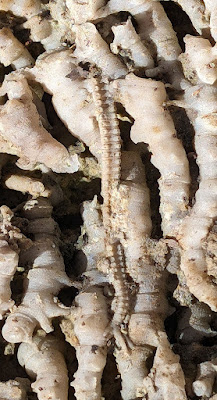Years ago I posted a picture of a fossil crinoid Myelodactylus convolutus (Hall, 1852) that is normally seen coiled up. This fossil specimen was elongated as when it died it was attached inside a colonial Entelophyllum eruciforme (Davis) coral. After reading up on this type of crinoid, this is a very rare occurrence of the crinoid preserved in this position to find in the fossil record (normally fossilized curled up).
This next picture shows the fossil with a scale. It is about 5 cm long. Note the remaining holdfast at the bottom of the crinoid fossil that anchored it to the coral. Each of those little holes would have contained a cirri.Unfortunately, the calyx or crown is missing from the top of this specimen.
Next to that fossil are the remains of an eroded crinoid which I cannot identify.
A year before his death, renowned crinoid researcher Frank Springer (1848-1927) of the United States National Museum published "Unusual Forms of Fossil Crinoids" in 1926 (LINK). This 137 page treatise mentions the Myelodactylus quite a bit with a number of images in the plates. It is found in the Silurian Period Rochester and Waldron Shales.In my opinion, this coral specimen should eventually be in the Smithsonian Museum of Natural History to be part of the Springer Collection of echinoderm fossils. Learn more at their web page as of this writing in March 2024. I believe there could be more Myelodactylus crinoids hidden in the coral that future scanning technologies will be able to non-destructively detect. The Smithsonian would have the resources to do instigate this research.




























